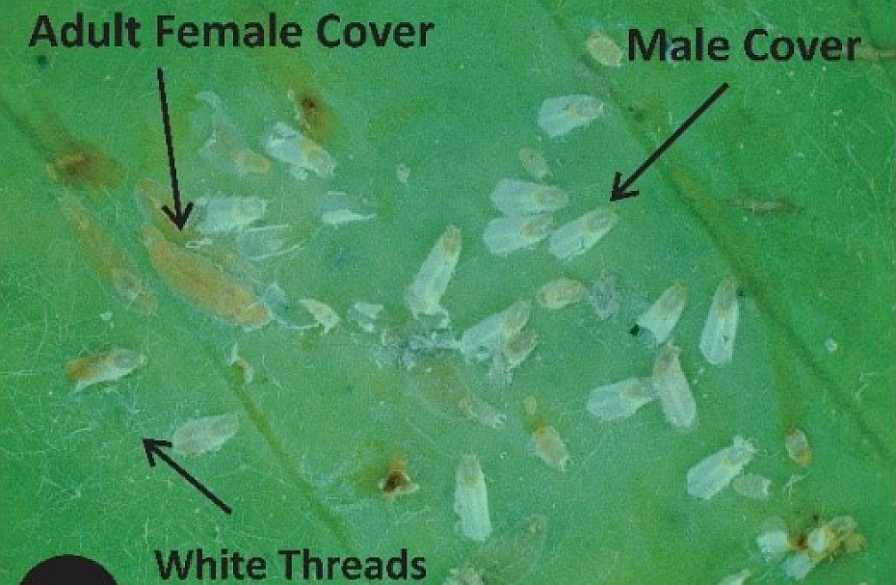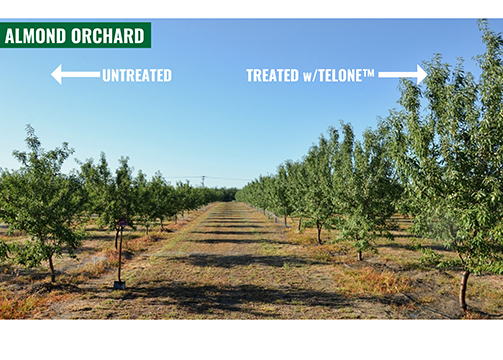Watch Out for Snout Scale in Florida Citrus

Here is a naked eye view of initial infestation of snout scale on the lower surface of a citrus leaf.
Photo courtesy of FDACS-DPI
As if Florida citrus didn’t have enough pests to contend with – enter the snout scale. The Florida Department of Agriculture and Consumer Services’ Division of Plant Industry (FDACS-DPI) recently sent out a pest alert for snout scale (Fiorinia proboscidaria Green) as a potential threat to local citrus.
The most recent finding of the pest was in Flagler County. This is not the first time a red flag has been raised for the pest in Florida. According to FDACS-DPI, the first continental record of snout scale was collected December 2013 in Hillsborough County, FL. There are at least 24 records after its first detection in Florida from five counties, including Hillsborough, Flagler, Pinellas, Putnam, and Santa Rosa.
All samples were collected from residential areas. This updated Pest Alert from FDACS-DPI is aimed at preventing its introduction to and establishment in commercial citrus-growing areas in Florida.
Here are some specs on the pest as provided by FDACS-DPI:
Identification
In old infestations, multiple stages of snout scale were found commingled on the lower surface of the leaves, causing chlorotic yellow patches. In early infestations, yellow-colored first instars (crawlers) and second-instar males with white wax were commonly observed on the lower surface of leaves. Second-instar male covers are white with three slightly elevated longitudinal ridges.
The shape of the snout scale cover resembles other Fiorinia species in Florida. Only one of them, tea scale (Fiorinia theae Green), has been found on citrus. The cover of Fiorinia species is elongate-oval and has a longitudinal ridge along the midline with the pale yellow exuviae of the first instar attached to the anterior end.
The adult female molts inside the enlarged exuviae of the second-instar female. The color of the cover of snout scale and related species of Fiorinia is generally a shade of brown, but in snout scale it is a lighter shade of brown compared to F. theae. Field specimens of Fiorinia species look very similar to one another, and to ensure correct species identification, specimens must be slide mounted to view the diagnostic characters used to distinguish the species.
Survival and Spread
There is no information about the biology of snout scale. Other Fiorinia species have multiple generations per year, and it is likely snout scale will be present year-round in Florida. Scale covers of Fiorinia species can remain on the leaf long after the scale itself has died. It is essential to determine if the scale is alive or dead since the adult female of Fiorinia species is protected and hidden by the cuticle of the second instar.
Host Plants
Almost all Florida records of snout scale are on citrus species except three. Those were on Cinnamomum camphora (L.) J.Presl., X Citrofortunella microcarpa (Bunge) Wijnands, and Ilex cornuta Lindl.
Distribution
In addition to Florida, snout scale has been reported from 20 countries in Africa, Asia (Bangladesh, China, Christmas Island, India, Indonesia, Iran, Japan, Sri Lanka, Taiwan), Europe (France), North America (Guadeloupe, Hawaiian Islands, Jamaica, Saint Lucia), Oceania (Fiji, French Polynesia, Tonga), and South America (French Guiana).
DYK?
There are 32 more scale insect species (including 15 armored scales, 10 soft scales, six mealybugs, and one other scale) reported on citrus in Florida.









